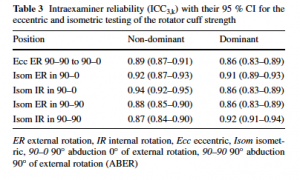The evaluation of muscle performance may be accomplished by using a number of tests, including manual muscle testing (MMT), isokinetic dynamometry, and hand-held dynamometry (HHD).
In the field of sports medicine, hand-held dynamometry (HHD) is gaining considerable interest over isokinetic testing, since the equipment is not expensive and easy to use on the field or training area of the athlete.
A hand-held dynamometer (HHD) is a portable measurement device often used for assessing muscle function.
Hip strength assessment plays an important role in clinical examination of the hip and groin region (Holmich et al., 2004), and clinical outcome measures quantifying hip muscle strength are needed.
Standardized strength assessments of hip abduction (ABD), adduction (ADD), external rotation (ER), internal rotation (IR), flexion (FLEX) and extension (EXT) using a hand-held dynamometer are shown below (Throborg et al., 2010).
Hip abduction strength, supine position
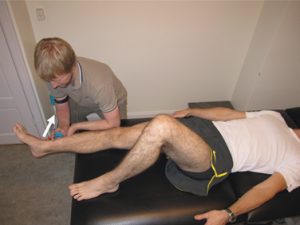
The person being tested is in the supine position, with the hip in neutral position. The test-leg and the resistance point are placed over the end of the table. The opposite leg is flexed. The person being tested holds on to the sides of the table with both hands. The examiner applies resistance in a fixed position and the person being tested exerts a maximum effort against the dynamometer and the examiner. The resistance is applied 5 cm proximal to the proximal edge of the lateral malleol, against hip abduction. The standardised command by the examiner is “go ahead-push-push-push-push and relax” (lasting 5 s).
Hip adduction strength, supine position
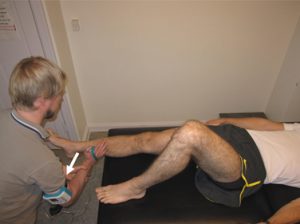
The person being tested is in the supine position, with the hip in neutral position. The test-leg and the resistance point are placed over the end of the table. The opposite leg is flexed. The person being tested holds on to the sides of the table with both hands. The examiner applies resistance in a fixed position and the person being tested exerts a maximum effort against the dynamometer and the examiner. The resistance is applied 5 cm proximal to the proximal edge of the medial malleol, against hip adduction. The standardised command by the examiner is “go ahead-push-push-push-push and relax” (lasting 5 s).
Hip abduction strength, sidelying position
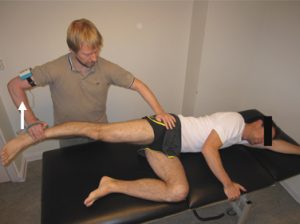
The person being tested is in the side-lying position, with the hip in neutral position. The opposite hip is in 90 degrees of hip flexion. The person being tested holds on to the side of the table with the upper hand and rest his head on the lower arm. The examiner stabilises the pelvis with one hand and applies resistance in a fixed position with the other. The person being tested exerts a maximum effort against the dynamometer. The resistance is applied 5 cm proximal to the proximal edge of the lateral malleol, against hip abduction. The standardised command by the examiner is “go ahead-push-push-push-push and relax” (lasting 5 s).
Hip flexion strength, supine position

The person being tested in the supine position, with the hip in 90 degrees of flexion. The person being tested holds on to the sides of the table with both hands. The examiner applies resistance in a fixed position and the person being tested exerts a maximum effort against the dynamometer and the examiner. The resistance is applied 5 cm proximal to the proximal edge of the patella, against hip flexion. The standardised command by the examiner is “go ahead-push-push-push-push and relax” (lasting 5 s).
Hip extension strength, prone position, long lever
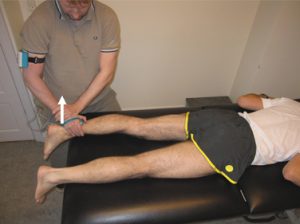
The person being tested is in the prone position, with the hip in the neutral position. The person being tested holds on to the sides of the table with both hands. The examiner applies resistance in a fixed position and the person being tested exerts a maximum effort against the dynamometer and the examiner. The resistance is applied 5 cm proximal to the proximal edge of the medial malleol, at the posterior aspect of the lower leg, against hip extension. The standardised command by the examiner is “go ahead-push-push-push-push and relax” (lasting 5 s).
Hip flexion strength, sitting position

The person being tested is in the sitting position, with the hip in 90 degrees of flexion. The person being tested holds on to the sides of the table with both hands. The examiner applies resistance in a fixed position and the person being tested exerts a maximum effort against the dynamometer and the examiner. The resistance is applied 5 cm proximal to the proximal edge of the patella, against hip flexion. The standardised command by the examiner is “go ahead-push-push-push-push and relax” (lasting 5 s).
Hip extension strength, prone position
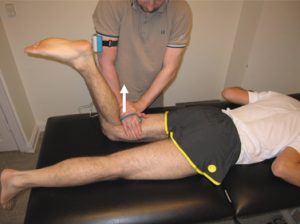
The person being tested is in prone position, with the hip in neutral position and the knee in 70–90 degrees of flexion. The person being tested holds on to the sides of the table with both hands. The examiner applies resistance in a fixed position and the person being tested exerts a maximum effort against the dynamometer and the examiner. The resistance is applied 5 cm proximal to the knee joint line, at the posterior aspect of the thigh, against hip extension. The standardised command by the examiner is “go ahead-push-push-push-push and relax” (lasting 5 s).
Hip internal rotation strength, prone position
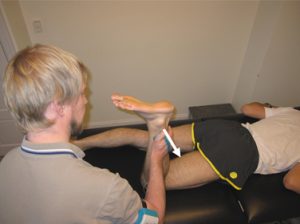
The person being tested is in the prone position, with the hip in neutral position and with 90 degrees of flexion in the knee. The person being tested holds on to the sides of the table with both hands. The examiner applies resistance in a fixed position and the person being tested exerts a maximum effort against the dynamometer and the examiner. The resistance is applied 5 cm proximal to the proximal edge of the lateral malleol, against hip internal rotation. The standardised command by the examiner is “go ahead-push-push-push-push and relax” (lasting 5 s).
Hip external rotation strength, sitting position

The person being tested is in the sitting position, with the hip in 90 degrees of flexion. The person being tested holds on to the sides of the table with both hands. The examiner applies resistance in a fixed position and the person being tested exerts a maximum effort against the dynamometer and the examiner. The resistance is applied 5 cm proximal to the proximal edge of the medial malleol, against hip external rotation. The standardised command by the examiner is “go ahead-push-push-push-push and relax” (lasting 5 s).
Hip internal rotation strength, sitting position
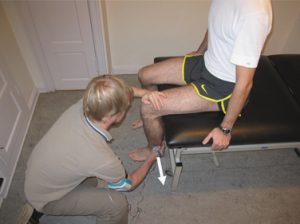
The person being tested is in the sitting position, with the hip in 90 degrees of hip flexion. The person being tested holds on to the sides of the table with both hands. The examiner applies resistance in a fixed position and the person being tested exerts a maximum effort against the dynamometer and the examiner. The resistance is applied 5 cm proximal to the proximal edge of the lateral malleous, against hip internal rotation. The standardised command by the examiner is “go ahead-push-push-push-push and relax” (lasting 5 s).
The reliability of HHD in measuring upper extremity strength has been favorable in the literature however, reliability may be compromised by testers who are unable to stabilize the device during testing.
Cools et al (2016) describes the following test positions for shoulder HHD testing with excellent inter- and intra reliability, all positions ICC >90.
- (1) Eccentric testing of the ER in an abducted position from 90° of ER to 0° of ER
For eccentric strength measurement, the protocol of Johansson et al (2015) was used:
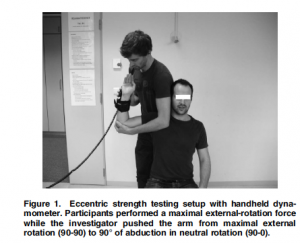
The subject was in a seated position, feet at shoulder width, the lower back supported against a chair, and held the elbow and shoulder at a position of 90° of abduction and 90° of external rotation (90– 90) with support from the examiners hand and forearm.
The HHD was positioned at a point 2 cm proximal of the processus styloideus ulnae and placed on the dorsal side of the forearm.
On the counting of the investigator, controlled by a metronome, the subject performed a maximal external rotation force, while the investigator pushed the arm from maximal external rotation (90–90) to 90° of abduction in neutral rotation (90–0) over a 3-s period. This procedure shows good-to-excellent intra- (ICC = 0.88, SEM = 11.1, %SEM = 9.2, MDC = 33.7) and interrater (ICC = 0.71, SEM = 14.1, %SEM = 12, MDC = 39.1) reliability, as well as good-to-excellent concurrent validity, when compared to the Biodex Isokinetic measurement
- (2 and 3) isometric strength testing of both IR and ER with the shoulder abducted 90° (90–0 position)
- (4 and 5) isometric strength testing of both IR and ER with the shoulder in 90° of abduction with 90° of external rotation (90–90 position)
The isometric testing was performed in a seated position, with the arm supported in 90° of abduction and neutral rotation (tests 2 and 3) or 90° of abduction with 90° or ER (tests 4 and 5). (Riemann et al 2010)
For each test, the participant was asked to perform the glenohumeral ER or IR against resistance of the HHD. A “make contraction” was used rather than a “break contraction”. Participants were asked to build their force gradually to a maximum voluntary effort over a 2-s period and hold the maximal voluntary effort for 5 s. The examiner kept the dynamometer in place, 2 cm proximal of the wrist, by matching the force exerted by the subject
These procedures were found to have good test–retest reliability, excellent intra- and interrater reliability (Cools et al 2016).
